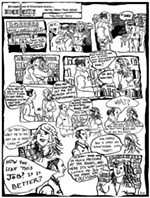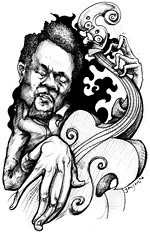Cubanisimo!
Ray Barretto and the Roots of Afro-Cuban Jazz
By Harvey Pekar, Fri., June 12, 1998
 Ray Barretto has not only witnessed momentous musical change in his lifetime, he has been at the center of it. As a lifelong purveyor of Afro-Cuban jazz, Barretto has been a pivotal figure in the fusion of jazz and Afro-Cuban rhythms, moving the musical hybrid toward the mainstream with his propulsive percussion work. "Because I love and respect the genre of jazz, I want to make sure that whatever we do has the language of jazz held in highest esteem," says Barretto, calling from his native New York. "That differentiates us from most bands that come under the `Latin Jazz' category. We play jazz with me providing the Latin overtones - the Latin air about it - but it's still something that caters to and respects jazz at the highest level possible."
Ray Barretto has not only witnessed momentous musical change in his lifetime, he has been at the center of it. As a lifelong purveyor of Afro-Cuban jazz, Barretto has been a pivotal figure in the fusion of jazz and Afro-Cuban rhythms, moving the musical hybrid toward the mainstream with his propulsive percussion work. "Because I love and respect the genre of jazz, I want to make sure that whatever we do has the language of jazz held in highest esteem," says Barretto, calling from his native New York. "That differentiates us from most bands that come under the `Latin Jazz' category. We play jazz with me providing the Latin overtones - the Latin air about it - but it's still something that caters to and respects jazz at the highest level possible."
Born in New York in 1929 and raised in Spanish Harlem, Barretto was exposed to his mother's Puerto Rican records early on, supplementing his childhood passions with the swing bands of the day - Ellington, Basie, Goodman. This music had a major impact on Barretto. "It helped me survive spiritually," he states.
At 17, Barretto joined the Army to get away from the poverty of the ghetto, and it was there that he became aware of the bop revolution, partly through his association with Belgian vibist Fats Sadi, who was working in Germany when Barretto was stationed there. It was in 1947, then, that Barretto's world was turned inside out by a bop record universally acclaimed for its groundbreaking sound: Dizzy Gillespie's "Manteca," on which the trumpeter bop band joined forces with Cuban percussionist Chano Pozo.
"That song blew my mind," says Barretto, never mincing words. "It was the basis of my inspiration to become a professional musician."
Nevertheless, the blending of bop and Afro-Cuban styles had been in the making for a while. In 1930, Louis Armstrong recorded a popular Cuban tune, "El Manisero." Six months later, Cab Calloway cut "Doin' the Rhumba." At the same time, in Havana, a classical woodwind prodigy, Mario Bauza, switched to trumpet and started playing with top Cuban pop groups. Immigrating to the States, Bauza started playing with big bands such as those of Chick Webb, Don Redman, Fletcher Henderson, and in 1939-40, Cab Calloway. Bauza became Calloway's musical director and during his stay, Cab recorded Latin-influenced tunes such as "Goin' Conga" and "Rhapsody in Rumba." Gillespie played in Cab's trumpet section with Bauza, and it was there that the two had serious discussions about Cuban music.
In 1940, Bauza left Calloway's orchestra to form a band fronted by his brother-in-law, vocalist Francisco Perez Gutierrez, better known as "Machito." Before long, Machito's Afro-Cuban band became one of the best and most popular of its kind, Bauza incorporating jazz elements into the group's arrangements.
Back in Havana, during the mid-Forties, tres (a guitar with three double strings) player-composer Arsenio Rodriguez had started a revolution with his combo, which employed complex rhythms and improvised solos by himself, pianists Ruben Gonzalez or Lili Martinez, and trumpeters Felix Chappotin and Alfredo "Chocolate" Armenteros. Cuban music and jazz began increasingly to resemble each other.
Gillespie remembered Cuban music after he'd established himself as a leader of the bop movement, so it wasn't surprising that he hooked up with Pozo to record memorable selections including "Cubana Be Cubana Bop" and "Manteca," or that Machito employed bop stars such as Howard McGhee as soloists; Machito later collaborated with Charlie Parker. The exciting product of this synthesis became known as Afro-CuBop, and jazz has had a strong Latin influence ever since.
Barretto returned from the service in 1949, got some drums, and taught himself to play by sitting in and "playing at every club, going to every jam session." His skills as a percussionist advanced. He got a job working professionally with Jose Curbelo, and stayed with him for four years. This was a relatively good period for Latin musicians thanks to the pop craze for mambos and cha chas. Once Barretto got into the loop, he remained there.
One night a few years later, a producer from Prestige, one of the major independent jazz labels, heard Barretto playing in Harlem and was impressed enough to ask him to appear on a recording session with Red Garland, who had established himself as a highly influential pianist with Miles Davis in the mid-Fifties. Around then, it was normal for a featured pianist to appear with a bassist and kit drummer; employing a Latino percussionist was unusual, though Mary Lou Williams had done it in 1953.
Barretto, however, had developed a unique swing style that he used in jazz contexts, and his work was very well received; so well, in fact, that he was soon recording with a number of name jazz men, including Lou Donaldson, Gene Ammons, and Wes Montgomery. Due to Barretto's influence, Latin percussionists appeared with increasing frequency in jazz groups, particularly those with a funky style.
Barretto continued to work in the Latin field as well. Tito Puente, who'd just lost Mongo Santamria to Cal Tjader's band, heard the percussionist and hired him on the spot. "Tito said, `Be at RCA studios tomorrow,'" recalls Barretto. "I went in cold." His initial LP with Puente was the very popular Dance Mania - not a bad way to break in.
By 1960, Barretto's work was much in demand. He'd practically become a house musician for the Prestige, Blue Note, and Riverside labels, quite an achievement for a guy who didn't start playing an instrument until he was almost 20. In the early Sixties, the charanga became quite popular, so Riverside officials asked Barretto to recruit musicians for a charanga session. Barretto countered by asking to lead, which Riverside okayed, so he picked up musicians from the Charlie Palmieri and Johnny Pacheco bands and made the date, his first as a leader.
At this time, New York became increasingly important as a center of Latin music. Cuba and the U.S. had broken relations, so no one really knew what was happening in the Havana music scene. émigrés in Florida weren't taking up much of the slack, either. However, the hundreds of thousands of Latinos living in the New York area had been developing a musical culture for decades, constantly enriching it with ideas from the many genres they heard. Latin funk and Latin boogaloo were popularized, for example, by Santamaria and Henry "Pucho" Brown.
After appearing on hundreds of recordings as a sideman, Barretto decided it was time to do his own thing. After leading the aforementioned Riverside date, he decided to become a leader on a permanent basis.
"Many great years of salsa followed," says Barretto. "Though [we were] not always commercially successful, the level of music was generally good and sometimes creative and great."
Before the decade had ended, Barretto had become a major figure in Latin music and had cut over 50 albums as a leader, most in Latin styles. If you can find it, a particularly rewarding Barretto album is Tommorow, a two-LP Atlantic recording containing work by the great Cuban trumpeter Alejandro "El Negro" Vivar. Vivar also appears on the currently available Barretto disc Carnaval on Fantasy. Hopefully that label, which now owns the Riverside catalog, will be reissuing more of Barretto's work.
References to music as an international language may be clichés, but they're true. As far back as the Forties, Cuban bands used American musicians. Now, salsa has spread throughout the world. It's played by French, Equatorial African, and Japanese musicians. In all probability, it's become a permanent part of the international pop music vocabulary. And now we appear to have gone full circle. It's illegal for people in the U.S. to import recordings from Cuba, but the music of that nation has been getting here indirectly on foreign labels such as World Circuit and Messidor, and plenty is worth hearing. Producer Joe Boyd of Hannibal records, aware of the exciting music scene there and fed up with the trade embargo, took matters into his own hands in 1995. After meeting with Cuban trumpet star Jesus Alemany in London, Boyd asked him to recruit an all-star Cuban band in Havana, then went there and recorded it. The resulting CD, Cubanismo, received international acclaim, and Boyd returned to Havana to cut two more.
Possibly because of Boyd's success, Nonesuch, in partnership with World Circuit, recently issued three CDs cut in Havana, one produced by Ry Cooder. They feature singers and instrumentalists who were in their prime in the Forties and Fifties, no longer spring chickens but still capable of generating excitement. Cuban music is returning to the States; even Jesse Helms may not be able to stop it.
Helms and his colleagues haven't been able to isolate Cuba from the rest of the world. That has been demonstrated in the field of music, where Cuban artists have been picking up American influences. The Cuban band Irakere contained some fine jazzmen, including Paquito D'Rivera. Havana pianist Gonzalo Rubalcaba is a brilliant artist whose work with Charlie Haden and Joe Lovano indicates that he's mastered both straight-ahead and avant-garde styles. The hybrid jazz/Afro-Cuban recordings made by Rubalcaba are also impressive. He began in Havana and Barretto in New York, but they seem to have arrived at similar musical conclusions.
Ray Barretto appears Sunday, June 14, 5pm at the Austin Jazz & Arts Festival. He'll be here with his group New World Spirit, which just issued its fifth CD, Contact!, on Blue Note with trumpeter Michael Phillip Mossman, woodwind player Adam Kolker, pianist John DiMartino, and a rhythm section sparked by Latin percussionist Barretto. For the concert, John Bailey will replace Mossman.








